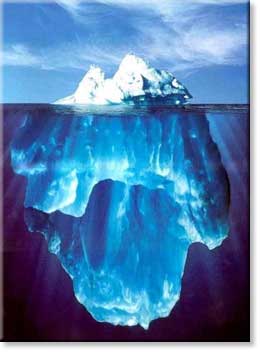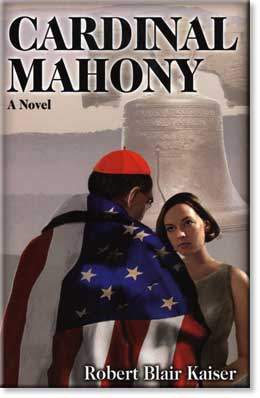Catholica (Australia)
July 18, 2008
http://www.catholica.com.au/peregrinus1/082_pere_180708.php
Icebergs are handy for metaphors because, as everyone knows, the great bulk of any iceberg is hidden; only the very top can be seen. A Google search returns 3.3 million hits for the phrase "tip of the iceberg". If more than a handful of those refer to an actual iceberg, I'll be astonished.
But icebergs have another feature almost equally useful to the maker of metaphors. They shrink in a very irregular fashion. Icebergs change shape all the time, through bits breaking off, through wind and wave erosion, through localised melting. The result is that an iceberg's centre of gravity is constantly shifting.
 |
| The American Church — likened to a great iceberg with a shifting centre of gravity |
Most of the time this isn't noticeable but, when the centre of gravity shifts just far enough, an iceberg will roll over without warning. If you happen to be nearby when that happens, you'll certainly notice. An iceberg can weigh up to 200,000 tonnes, and it displaces a similar mass of water. That makes for some very big waves when a berg rolls. If you survive the turmoil, when the waves die down you'll see what looks like a completely different iceberg.
For Robert Blair Kaiser, the American church is an iceberg, just waiting for the choppy wave, or the slightly warm wind from the right quarter, or the fracture at just the right point which will nudge the centre of gravity past the tipping point. And then the berg will roll.
An overview of Cardinal Mahony — A Novel…
In this novel, Kaiser imagines the American church rolling, or at least starting to roll.
To do this, he has to start with the nudge, the small impulse that sets off the chain of large events. For this purpose he rather implausibly imagines the Archbishop of Los Angeles being kidnapped by a group of militant liberation theologians, brought to a remote jungle location and subjected to a show trial for his sins and failings as a bishop. This takes up the first five chapters of the novel; the remainder is devoted to exploring how the Archbishop is changed by this experience, how he seeks to change the American church, and how Powerful Vested Interests seek to stop him.
 |
| Cardinal Mahony - A Novel by Robert Blair Kaiser
|
The novel is written in a genre new to me; reality fiction. The archbishop who is subjected to this ordeal is not a fictional character; but the current real-life current archbishop of Los Angeles , Roger Mahony. And, Kaiser assures us in his foreword, the facts brought out in his trial are real, and can be documented. The trial itself and subsequent events are of course imagined but, Blair tells us, he has tried to write so that Mahony's response to these imagined events, and indeed the actions of other characters borrowed from reality, is "in character", or at least plausible.
Mahony is not alone; the book abounds in real characters, drawn from the church, American politics and the American media – the worlds most familiar to the author. Apart from Roger Mahony; Pope Benedict, the current US President and Secretary of Defense, Cardinal Re of the Congregation for Bishops, Cardinal Bertone of the Vatican Secretariat of State, Bill O'Reilly of Fox News, John Allen of the National Catholic Reporter, the filmmaker Michael Moore, the retired Archbishop Quinn of San Francisco, Fr Richard John Neuhaus, Sr Joan Chittister and a host of others all have speaking parts of greater or lesser significance.
Fictional characters to carry the plot along…
There are fictional characters as well; there have to be, in order to carry the plot along. In particular, the villains of the piece have to be fictional. So we have a fictional Archbishop of Philadelphia, a fictional chancellor of the Diocese of Los Angeles, and so forth.
The book has an entertaining plot, which I don't want to give away. It's enough to say that it's a ripping yarn. But this book is not really plot-driven; the plot is mostly just a vehicle for Kaiser to lay out his vision of how the American church could be, and how it might get there from where it is today. So we can excuse a few gaps and implausibilities. At one point, for instance, Cardinal Re is made to appear unfamiliar with the word "anamnesis". It is unthinkable that he would not know the word, but a reader might very well not know it, and Cardinal Re's ignorance offers an opportunity for another character – Cardinal Levada, as it happens – to explain it.
You can't help feeling that Kaiser is having a certain amount of fun. Archbishop Quinn of San Francisco gets only one scene, where it takes him "several days" to return a phone call from Mahony. The lateness of the response has no significance for the plot; is Kaiser simply having a joke which will appeal only to those who know Quinn and his habits? And Bishop Olmsted of Phoenix – Kaiser's home town - appears in a non-speaking part at his own funeral; can we guess at a certain coolness between Olmsted and Kaiser?
Nobody ever puts an articulate case for a conservative vision…
But fun can slip over into indulgence. There are a number of television discussions about the future of the church between progressive and conservative Catholics; invariably the progressives score astute and witty points, while the conservatives end up spluttering or floundering. And the most prominent opponents of the conservative vision turn out to be motivated by financial corruption and sexual hypocrisy. Sympathetic as I am to Kaiser's vision, all this is gratifying to me, but it is a bit of a cop-out. Despite the set-piece debates nobody ever puts an articulate case for a conservative vision, or even subjects Kaiser's vision to any serious critique.
The result, ironically, is that Kaiser's vision of the church is not explored as fully as it might be. Kaiser's characters argue, for instance, that the American church doesn't need the pope's permission to govern itself in disciplinary matters, while remaining fully in communion. I can't help suspecting that the true position is more nuanced than that, though. The pope's permission may not be needed, but his agreement certainly is.
I think this book is more likely to please those who already share Kaiser's vision than it is to win over those who don't. But its purpose may not be to win people over, so much as to encourage the true believers, and to suggest that the possibility of change could be closer than it sometimes seems. While the imagined events which lead Mahony to change his mind are fairly far-fetched, the real point is that a change of heart by just one influential church leader could have far-reaching results.
Just how far-reaching? Well, Kaiser doesn't say. Mahony starts the iceberg rolling, but when the book rather abruptly ends it hasn't settled in a new alignment. In fact, the really big waves are just beginning. In an afterword, Kaiser encourages the reader to "stand by for the sequel". But I'm not convinced that he intends to write another novel. Remember, what Kaiser has written is "reality fiction"; a sequel doesn't have to come from the "fiction" element of that expression. A novel is a work of the imagination, but imagination is also the foundation for new realities; Kaiser may be encouraging us to look to the real world for the next chapter in the church's story.
Publisher & Availability info:
Cardinal Mahony — A Novel. by Robert Blair Kaiser, Humble-bee Press, Phoenix, 2008
ISBN: 9780964664296 Available from www.amazon.com and www.robertblairkaiser.com
Distributed in Australia by John Garratt Publishing www.johngarratt.com.au
By arrangement with John Garratt you can also order online through this Catholica Australia LINK.
Any original material on these pages is copyright © BishopAccountability.org 2004. Reproduce freely with attribution.